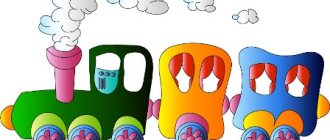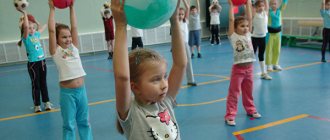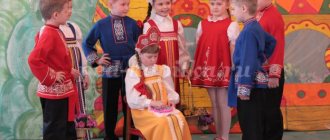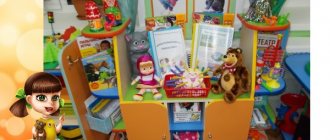Why do you need to dramatize a fairy tale in kindergarten?
It is difficult to overestimate the importance of theatrical activities in a preschool educational institution. In the process of learning and showing the production, the child is raised, morally and physically. Children come to kindergarten to join society; they must learn to speak in public, memorize text, and get involved in gaming or work processes. The teacher’s task is to conduct an interesting game, inserting a cognitive element into it and arousing interest among young actors. Dramatizing a fairy tale in a preparatory group helps show children how they can and cannot behave in different situations.
Matinee in kindergarten
Important! Performances in kindergarten are carried out in accordance with the Federal State Educational Standard, according to the approved program. You can choose well-known fairy tales, such as “The Clapping Fly” or “Little Red Riding Hood,” or show your imagination and stage an unusual production.
The easiest way to introduce a preschooler to national culture is through Russian folk art. At the age of 5, children absorb the wisdom and beauty of fairy tales like a sponge, let everything pass through them, and for the first time think about what is good and what is bad.
Another, no less important goal is aesthetic education. Staging Russian folk works allows you to:
- to cultivate moral ideals and responsiveness;
- develop interest in gaming and theatrical activities, Russian folk art;
- develop musical and acting abilities;
- show the child how to show emotions in facial expressions, gestures and movement;
- talk about the traditions of the Russian people, nature and customs;
- enrich the preschooler’s speech, use unfamiliar words, explain their meaning;
- develop thinking, attention and memory in a child.
Children from the younger group can prepare a fairy tale and role-play it. A New Year's or autumn party is perfect for this. You can also prepare a fairy tale for the holiday for mothers and for the autumn holiday. In general, 3-5 dramatizations can be prepared per year.
Autumn holiday
Note! The performance should not last longer than 15 minutes. Children who go to kindergarten are not yet ready for long performances. Dramatization is primarily a game, which means kindergarten students can laugh, dance and chat happily with each other.
Plan of theatrical activities in the preparatory group
Oksana Dedushchenkova
Plan of theatrical activities in the preparatory group
Plan of theatrical activities in the preparatory group
September
1. Sketches for the expressiveness of movements, for the expression of emotions: “Ill-mannered mouse”, “The mouse wants to play with friends”, “The mouse makes peace with friends”. Learn to find expressive means in facial expressions, gestures, intonations.
2. Recite poems with your hands: “Playing instruments”, “Haymaking”, “Centipede”. Learn to convey the content of poems using your hands.
3. Reading the work
K. Chukovsky “The Tsokotuha Fly.” Introduce the work of K. Chukovsky “Telephone”.
4. Dramatization of a fairy tale
K. Chukovsky “The Tsokotuha Fly.” Teach children to participate in a collective dramatization of a work in a timely manner; express the character’s state using facial expressions, voice, and intonation.
October
1. Pantomime tasks. Continue to develop a sustainable interest in theatrical play activities.
2. Meeting with familiar fairy tales. Fairy tale by Charles Perrault “Puss in Boots”
Help relieve psychological stress and muscle relaxation.
Remember a familiar fairy tale.
3. Table theater "Puss in Boots".
Learn to wield a doll, coordinate words with driving the doll.
4. Imagine. Games with tasks. Induce a joyful emotional mood in children; develop basic skills of facial expressions and gestures; teach children to pronounce phrases intonationally; develop imagination.
november
1. Staged improvisations.
Develop creativity.
2. Conversation about the theater. Didactic games “Meetings of heroes”, “Sound engineers”. Expand the vocabulary of theatrical terms.
3. Reading the fairy tale “The Bag of Apples”
Introduce children to the fairy tale “The Bag of Apples.” Develop imagination, facial expressions, gestures, plasticity.
4. Dramatization of the fairy tale “The Bag of Apples”
Learn to convey the character of the characters and their attitude towards people using facial expressions and intonation.
December
1. Theatrical game library “Funny Poems”.
Strengthen the ability to use theatrical puppets. Develop clear, expressive speech.
2. Quiz on Russian folk tales. Remember Russian folk tales.
3. Reading the Russian folk tale “The Wolf and the Fox.”
Continue to participate in theatrical activities, try to express yourself in different roles, and experience the joy of communication.
4. Puppet theater “Wolf and Fox”.
Help children experience a sense of satisfaction from the result of creative work.
January
1. Sketch “Kittens”, “Sun”.
Development of imagination, plasticity, facial expressions.
2. “Funny compositions.”
Encourage children to create simple stories with children as their heroes. Develop children's coherent speech (dialogical).
3. Telling the fairy tale “The Wolf and the Seven Little Goats” (table theater).
To foster children’s desire to tell and show fairy tales to other children.
4. Rhythmoplasty.
Develop flexibility and mobility of hands, fingers and arms.
February
1. The play “The Wolf and the Seven Little Goats.” Learn to wield a doll, coordinate words with driving the doll.
2. Reading the fairy tale by H. H. Andersen “Thumbelina” Introduce the children to the fairy tale. Learn to convey the character of the characters and their attitude towards people using facial expressions and intonation.
3. The fairy tale “Thumbelina”
(play).
Exercise the ability to convey the character of the characters and their attitude towards people using facial expressions and intonation.
4. Dramatization “Who is the most beautiful in the forest.” Develop creativity.
March
1. Role-playing game “Theater”
Teach children to pronounce a given phrase with a certain intonation in combination with gestures. Develop communication skills, learn to combine melodious speech with plastic movements.
2. Reading the fairy tale “The Fox and the Crane” Develop conversational speech. To reinforce in children the idea that there is a wise lesson in a fairy tale.
3. Puppet theater “Fox and Crane” Develop creativity, imagination and fantasy.
4. Reading the fairy tale “The Cat, the Rooster and the Fox.”
Remember the content of the fairy tale.
April
1. Rehearsal of the fairy tale “The Cat, the Rooster and the Fox.” .
Work on text and voice.
2. Rhythmoplasty.
Develop the ability to convey the character and mood of music in free improvisations.
3. Preparation for the play “The Cat, the Rooster and the Fox.”
Improve intonation expressiveness of speech.
4. Screening of the play “The Cat, the Rooster and the Fox.” Help children experience a sense of satisfaction from the result of creative work.
May
1. Reading the fairy tale “Zayushkina’s hut.”
Introduce the fairy tale “Zayushkina’s Hut” in poetic form.
2. Dramatization of “Zayushkina’s Hut.” Learn to convey the character of the characters using facial expressions and intonation.
3. Reading the fairy tale “Forest School”. Introduce a new fairy tale.
4. Dramatization of the fairy tale “Forest School”.
Develop creativity, learn to improvise.
Imitation games in the preparatory group
A lot of preparatory work is done before the performance. To fully immerse yourself in the action taking place on stage, you will need the following props:
- musical recordings with a fairy tale theme;
- masks and caps of heroes, for example, a wolf or a fox;
- cardboard decorations that kindergarten students can make with their own hands with the help of a teacher;
- cards with riddles;
- items to create a fabulous atmosphere: mugs, napkins, sweets in vases, carpet runners.
Children, together with the teacher, assign roles and learn their words, look at illustrations for the chosen fairy tale, read it and discuss it.
Important! The teacher must make sure that each child understands the meaning of the text.
What fairy tales are suitable for production in a preparatory group?
Many fairy tales are suitable for dramatization in kindergarten, for example, “Pinocchio”, “How Maya the Doll Baked a Pie”, “Thumbelina”, “Cat’s House”, “Tsokotukha Fly”. The little-known fairy tale “Lada” is also suitable for production. Children get acquainted with different types of works, even those they have never heard of before.
An adult leading character must be identified. In the fairy tale “How Maya the Doll Baked a Pie,” it is the Storyteller who is the first to take the stage and begin to speak. The teacher involves the children in the game with simple words, like these:
Entertaining mathematics in games for preschoolers
"Hello my friends.
I came to visit you.
I'm glad to see you all.
My name is the storyteller.”
The teacher is the main presenter
The fairy tale Thumbelina at first glance may not seem easy to implement, just like the Cat's House, the Turnip, the Wolf and the Seven Little Goats.
cat house
The popular children's fairy tale, familiar to everyone from a very young age, “The Cat's House,” is also suitable for theatricalization in the kindergarten preparatory group.
Goals of the production:
- development of correct literary speech and pronunciation in children;
- formation in the child of an integral picture of the world, an understanding that he lives in society;
- presenting safety rules in an accessible form.
The scenery for this fairy tale is simple; all you need is a cardboard house and costumes for all the children. For the game you will also need fire extinguishers, but not real ones, but cardboard ones. You can paint regular plastic bottles red.
During the action, children sit on the lawn in front of the house, “drink tea,” and talk. When the music starts, the children sing and dance, and then the performance begins.
The main goal of this production is to teach the child safety rules. Since they will put out a fire in the house using a fire extinguisher, children will quickly remember what this item is and why it is needed.
Cat house in a new way
Teremok
Many children really like the fairy tale “Teremok” and this is an excellent option for dramatization at a matinee.
In this tale you need to distribute several roles:
- teacher (leading person);
- Mouse;
- Bunny;
- Fox;
- Wolf;
- Bear.
To stage a fairy tale, five children are chosen to play the main roles, but all the others must also be involved in the performance. The best way is to allocate “spectators” and “participants”, who switch places after a few minutes. Children who watch the performance play along with the main characters, clap, “cry” and laugh with them.
Another version of the dramatization, dividing the fairy tale into two parts: speech and fingers. First, children read the text according to the usual script:
Mouse: “Who lives in the little house? Who lives in a low place?
Teacher: “No one answered. The mouse entered the house and began to live there.”
The frog-frog galloped up to the tower and asked: “Knock, knock. Who lives in the mansion?
When the entire fairy tale has been played out, the rest of the children get up from their chairs and begin to “build a tower”, making various movements. They knock fist against fist, imitating hammering, raise their arms high, showing how big the roof will be, and “call for guests” by waving their arms.
Teremok in kindergarten
To make the game interesting, you need to choose the right scenery. The facade of the tower is made from cardboard; you can also put chairs, covering them with fabric, place a spikelet near the house and a table with cups and a kettle.
Kolobok
In the preparatory group of a kindergarten, you can organize a show of the fairy tale “Kolobok” in a new way. To make the production truly bright and interesting, you need to prepare the props in advance:
- hut with an open window;
- table with samovar and cups;
- high chairs for all children;
- a vegetable garden next to the house, you can use ordinary boxes covered with green paper;
- forest. Trees can be made from cardboard, or strips of green fabric can be hung from the ceiling.
The main attribute, without which the performance would not be complete, is a pot of “dough” near the hut. A child can play kolobok; for this they are given a large round ball or a foam toy.
Characters of the fairy tale: the leader (teacher), the old man and the old woman, the bun, the hare, the wolf, the bear, the sly fox.
The words for the production can be taken from a traditional fairy tale, or slightly altered, for example, “I left my grandmother, I left my grandfather,” turns into: “Kolobok, I’m a fidget. They baked me for my grandfather. I'm mixed with sour cream, I'm cold at the window. I left the old people. Jump from the window, and that was it.”
Theatricalization of the fairy tale Kolobok
In order for all the children from the preschool group to be involved in the fairy tale, you need to learn the movements with them. When the presenter says that the grandfather and grandmother are digging a vegetable garden, all children can depict this scene.
How children dance in kindergarten in a playful way and with an accelerated tempo
Zayushkin's hut
The fairy tale “Zayushkina’s Hut” is suitable for dramatization in a preparatory group at a New Year’s party. The whole group takes part, and the children are given roles: hare, rooster, greedy fox, dog, bull, wolf, bear.
The fox took over Zayushka's house, asking for a visit, and kicked out the owner, but the bunny is brave and seeks help from the animals. The main phrase for a child playing a hare: “How can I not cry? I had a bast hut, and the fox had an ice hut. She asked to spend the night and kicked me out.”
This is followed by a list of animals that have already tried to help the hare and a new attempt to occupy the house.
Note! An activity such as staging a fairy tale in kindergarten, especially the fairy tale about Zayushka’s hut, helps to cultivate empathy in children. At the end, the teacher asks everyone to take pity on the bunny and not offend him, and the children happily do this.
Goat Dereza
The Russian folk tale “The Goat-Dereza” is little known to children, and to introduce the children to it, it is best to stage a theatrical performance. To theatricalize “The Goat-Dereza,” the teacher carries out preliminary work, reads the fairy tale with the children, creates a script for the performance, and prepares the scenery.
For installation you will need:
- hut or house, the structure must be stable;
- imitation trees;
- costumes and hats for each participant;
- You can put decorative fruits and vegetables in a bag: apples, beets, carrots and place them in front of the house.
The teacher begins the speech with simple and understandable words: “Whether close, far, where we don’t know exactly, Grandfather and Grandmother lived.”
Goat-Dereza Costume
Grandfather and Grandmother, goats, granddaughter, bee, bear, wolf and hare come onto the stage. A children's matinee is not an obligation, but a game, but do not forget and aim at an educational moment.
Summary of theater classes in the preparatory group
Summary of a lesson in the preparatory group on the topic “Journey to the fairy-tale country “Kuklandia”
Description of the material: theaters: finger, mitten, puppet, bibabo dolls for the fairy tale “Mitten”, painted portrait of a person, gouache, brush. Goal: fostering a love for theater, developing interest in this art form. Objectives: To acquaint children with the features of conveying a theatrical image through various means: with the help of makeup, plastic movements, gestures, facial expressions.
To promote the accumulation in children of ideas about various types of puppet theater. To introduce children to theatrical culture, to awaken interest in theatrical and play activities, to create the necessary conditions for its implementation. Progress of the lesson.
Educator: Guys, today I invite you to the magical world of theater.
I'll ask you a very simple question: do you like to play? (Yes, we do!) - When you play, you take on a role or transform yourself (transform). In whom? (As a doctor, hairdresser, salesman, etc.) - Tell me, does this happen to adults when they also reincarnate, i.e. play roles? (This happens with theater artists.) Educator: Adults work as actors in the theater and, preparing for a performance, create someone’s image and play a role. I want to invite you to play a role, but you must guess the riddle and find out what role you need to play. He pulled jokes out of a hat, He has a lot of jokes! Made me and dad laugh, we laughed until we cried. He deftly jumped on the rope and threw balls into the air. Have you guessed, children, who he is? Well, of course, this is... (clown.) (G. Lapteva) Game “Draw a mask.” Show children the face of an ordinary person drawn on a piece of paper. - What needs to be done to make a clown? (Draw a mask on the face: eyebrows, nose, cheeks, smile, wig.) Educator: And all this is called in one word - makeup. Make-up is a mask with which an actor creates the external image of his character. It helps the artist to transform himself and create a bright, expressive image. How many of you have been to the theater? (Children's answers). What is theater? (Children can say that a theater is a large, beautiful building in which performances are held.) At all times, people came to the theater to relax. They come there with families and friends. Theater helps people be kinder and better. A fairy tale lives in the theater. There are many types of theater in our group: Finger Theater.
Mitten Theater.
Puppet show
There is also a flannelgraph theater, a cone theater, etc. Look, guys, our guests today are theatrical puppets. What do you think, heroes, what kind of fairy tale are gathered here? If you guess the riddle, you will find out the name of the fairy tale that the guys from the group will show you. Four brothers live together, and one is in the department. (Mitten.) Showing the fairy tale “Mitten.”
Educator: everyone did an excellent job with their role. You were real artists, and artists come out to bow after the performance.
We recommend watching:
Do-it-yourself Dalmatian paper toys Musical-themed fairy tale for older preschoolers with elements of life safety for preschoolers A theatrical sketch for older preschool-aged children. Scenario A theatrical performance based on the fairy tale Mitten in the senior speech therapy group of a preschool educational institution. Scenario
Similar articles:
Riddles about puppet theater
Summary of a lesson in the preparatory group on the topic: Spring
Playful musical entertainment for children of the preparatory group in kindergarten. Scenario
Spring leisure in the preparatory group. Semik - Russian rite of flowering
Fun in the preparatory group. Russian customs
Card index of dramatization games with goals
To simplify preparation for the holiday, the teacher creates a card index of fairy tales in advance, and on each card indicates a goal, for example, “developing the desire for mutual assistance” and the name of the fairy tale: “Turnip.”
There are several drama games that can be played at any time to entertain children and develop one or another skill:
- Pinocchio and Pierrot. The purpose of the game is to show children how to properly relax and tense their body muscles. Children move slowly around the hall, but on command from Pinocchio they must stand in a pose: feet shoulder-width apart, muscles tense, arms bent at the elbows and raised above the head. If Pierrot gives the command, then the child takes on a sad look, his neck is relaxed and hanging, his eyes are downcast;
- Hypnotist. The purpose of this performance is to teach the child to relax the whole body and rest. The teacher becomes a hypnotist, and imitating a hypnosis session, moves his hands in front of the children’s faces, saying “Sleep, sleep.” Children first lower their head and neck, and slowly lie down on the floor and “fall asleep”;
- Goose. Children imitate the gait of a goose and walk with their necks craned and their hands folded behind their backs. You can also invite them to portray other animals and birds.
- Pantomime. Children really like the theatrical version of the game, they become actors and get into character, depicting different actions: getting dressed for going outside and undressing, washing and drying the dishes, sweeping the floor in the kindergarten, watching the falling snow, playing with the cat.
Additional Information! In order to choose an interesting game at any time, the kindergarten must have a card index. During the teaching hour, the teacher takes out a card and, depending on what is written on it: “Little Red Riding Hood” or “Swan Princess,” plays the game. This is an unusual and interesting way to raise children, develop attention, fine motor skills, and acting abilities.
To involve children, you can hold various competitions, for example, for the most unusual costume, or the best Russian folk souvenir, made with your own hands.






